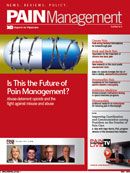Publication
Article
Pain Management
In Case You Missed It: Fibromyalgia Research in 2011
There was a wealth of important fibromyalgia treatment-related research presented at major pain conferences in 2011.
There was a wealth of important fibromyalgia treatment-related research presented at major pain conferences in 2011.
Abstracts from the American College of Rheumatology annual meeting, held November 5-9, 2011.
For more, visit http://bit.ly/rIkRUO.
Treatment with Electrostimulation May Produce Long-term Beneficial Effects in Patients with Fibromyalgia
In this study, Hargrove et al. reported on long-term outcomes of Reduced Impedance Noninvasive Cortical Electrostimulation (RINCE) in patients with fibromyalgia (http://bit.ly/sm2ctv). Baseline Fibromyalgia Impact Questionnaire (FIQ) scores were compared to scores at the end of treatment and at follow-up (average time was 45 months post-therapy). Mean FIQ score was 53 at baseline, 36 at end of treatment, and 32 at follow-up. According to the authors, subjects reported “symptom improvements lasting at least two-years in pain (68%) sleep (56%) and fatigue (60%).” More than three-fourths of patients (76%) reported that they had “reduced or completely eliminated medicine use for pain;” 71% reported “reduced or eliminated need to see physicians” for treatment of their fibromyalgia.
Lower Dose of Duloxetine Does Not Improve Pain Scores in Fibromyalgia
Arnold and colleagues (http://bit.ly/tySxDy) evaluated the safety and efficacy of lower-dose (30 mg) duloxetine compared to placebo in patients with fibromyalgia with or without major depressive disorder (MDD). This trial looked at changes to pain severity score on the Brief Pain Inventory-Modified Short Form (BPI) over 12 weeks of treatment. The authors reported that “Duloxetine- treated patients did not have statistically significant BPI average pain reduction compared with placebo-treated patients,” although they did observe a “significant improvement in duloxetine-treated patients compared with placebo-treated patients assessed by PGI-I endpoint score.”
Abstracts from the American Academy of Pain Management annual meeting, held September 20-23, 2011.
For more, visit http://bit.ly/tj805i.
Fibromyalgia Affects Nearly Every Facet of Sufferers’ Lives
In “Understanding Fibromyalgia: Online Patient Survey of NFA Members,” Casey et al. reported on data collected from more than 10,000 online survey responses received from National Fibromyalgia Association members. Unsurprisingly, the vast majority of survey responses (95%) were from women. The authors reported that at least 30% of survey respondents experienced the following symptoms, ranked at least 8 out of 10 in severity: Chronic, widespread pain; problem sleeping, fatigue; sensitivity to touch; difficulty concentrating; poor memory; depression; joint pain; stiffness; and sensitivity to noise/light/odor/cold. The survey results also revealed the impact of fibromyalgia on patients’ ability to work: more than half (51.4%) of survey respondents were unemployed, and of those who were employed, 11.1% missed more than 20 days of work in the past year, 9% missed 10-20 days, and 17.7% missed 1-9 days. Relief from symptoms was also hard to come by, with more than 38% of respondents reporting they were “not at all” or “not very” satisfied with their current treatment.
Milnacipran Effective in Reducing Pain in Patients with Fibromyalgia
Frisolone et al. reported in “Milnacipran Improves FM Symptoms, Regardless of Severity” analyzed data from three trials in which patients (more than 3,000 patients total) were randomized to milnacipran 100 mg/day, 200 mg/day, or placebo, with efficacy assessed according to improvement from baseline in VAS pain scores, Patient Global Impression of Change (PGIC), and “a 2-measure composite responder analysis (individual patients were required to meet both pain and PGIC responder criteria).” The authors reported that patients treated with milnacipran experienced “significantly greater pain, PGIC, and 2-measure responder rates, regardless of baseline pain severity group.” When data was stratified according to Fibromyalgia Impact Questionnaire total score, in all subgroups “pain, PGIC, and 2-measure responder rates were significantly greater with milnacipran treatment than with placebo,” except for patients with an FIQ total score <39 for 100 mg/day, 2-measure composite responders, and 200 mg/day pain responders.
Abstracts from the American Academy of Pain Medicine annual meeting, held March 24-27, 2011.
For more, visit http://bit.ly/v9XVRL.
Milnacipran Plus Pregabalin Reduces Pain and Improves Functioning in Patients with Fibromyalgia
Farmer et al. (http://bit.ly/w1uXqp) assessed the efficacy and tolerability of adding milnacipran 50 mg to pregabalin 150 mg or 225 mg in patients with fibromyalgia who had “an incomplete response to pregabalin during an open-label run-in phase” (defined for this study as patients with VAS pain scores of 40-90, Patient Global Impression of Severity score of 4 or higher, and a Patient Global Impression of Change score of 3 or higher). At endpoint, combination milnacipran/pregabalin treatment “resulted in a significantly higher percentage of PGIC responders than pregabalin alone.” Patients who received combination treatment also experienced “significant mean improvements compared with pregabalin alone on other domains, including pain, physical and mental functioning, fatigue, and cognition.”






